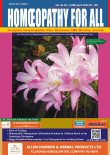Homeopathic Management of Alopecia Based on Causative Factors
Keywords:
Alopecia, cultural standards, homeopathyAbstract
Hair is crucial in shaping human self-image and personal identity. It's one of the minority of physical characteristics that can be readily changed and controlled in accordance with cultural standards and fashion fads. Alopecia, often known as hair loss, is a prevalent issue that impacts millions of individuals. Although alopecia areata may occur at any age, the majority of people get the disorder early in life. More than 80% exhibit indications of the disease before the age of 40, with 40% experiencing symptoms by the age of 20. According to research, women are more prone than males to acquire alopecia areata, and certain races and ethnicities may be more susceptible to the disorder. It is essential to understand the intricate structure of hair, particularly when addressing the most prevalent causes of alopecia. The normal hair growth cycle can be disrupted and result in hair loss due to factors such as stress, hormonal imbalances, nutritional deficiencies, and genetic predispositions. Hair performs fundamental roles like thermoregulation, friction reduction, sun protection, and sensory organ function. Traditionally, hair on the head was considered a defensive shield and is still considered a prime symbol of personal identity. Yet, a range of hair-related problems including alopecia, insufficient hair growth, early graying, dandruff, thinning, and lack of shine are typical worries. The variety of features of hair, including its form, length, diameter, texture, and colour, along with the structure of its cross section, might impact the curl of the hair.
Downloads
References
1. Sy, N., Mastacouris, N., Strunk, A., & Garg, A. (2023). Overall and racial and ethnic subgroup prevalences of alopecia areata, alopecia totalis, and alopecia universalis. JAMA dermatology, 159(4), 419-423.
2. Alonso, L., & Fuchs, E. (2006). The hair cycle. Journal of cell science, 119(3), 391-393.
3. Cheng AS, Bayliss SJ, “The genetics of hair shaft disorders.” J Am Acad Dermatol 2008;59(1):1- 22.
4. Zhuo FL, Xu W, Wang L, Wu Y, Xu ZL, Zhao JY. Androgen receptor gene polymorphisms and risk for androgenetic alopecia: a meta
analysis. Clin Exp Dermatol. 2012 Mar;37(2):104-11. doi: 10.1111/ j.1365-2230.2011. 04186.x. Epub 2011 Oct 10.
5. Thangapazham RL, Rajeshkumar NV, Sharma A, Warren J, Singh AK, Ives JA, Gaddipati JP, Maheshwari RK, Jonas WB. Effect of homeopathic treatment on gene expression in Copenhagen rat tumor tissues. Integrative Cancer Therapies. 2006 Dec;5(4):350-5.
6. Zouboulis, C. C., Blume-Peytavi, U., Kosmadaki, M., Roó, E., Vexiau-Robert, D., Kerob, D., & Goldstein, S. R. (2022). Skin, hair and beyond: the impact of menopause. Climacteric, 25(5), 434-442.
7. Almohanna, H.M., Ahmed, A.A., Tsatalis, J.P. et al. The Role of Vitamins and Minerals in Hair Loss: A Review. Dermatol Ther (Heidelb) 9, 51–70 (2019). https://doi.org/10.1007/s13555-
018-0278-6
8. Peters EMJ, Müller Y, Snaga W, Fliege H, Reißhauer A, et al. (2017) Hair and stress: A pilot study of hair and cytokine balance alteration in healthy young women under major exam stress. PLOS ONE 12(4): e0175904. https://doi.org/10.1371/journal.
pone.0175904
Sanchez, D. A., Scott, K., & McMichael, A. (2007). Alopecia areata. International journal of dermatology, 46(2), 121-131.
10. Natarelli N, Gahoonia N, Sivamani RK. Integrative and Mechanistic Approach to the Hair Growth Cycle and Hair Loss. Journal of Clinical Medicine. 2023; 12(3):893. https://doi.
org/10.3390/jcm12030893
11. W. Boericke, New Manual of Homoeopathic Materia Medica & Repertory [with Relationship of Remedies], Second Re-Augmented & Revised Edition Based on Ninth Edition, Reprint Edition 2002, B. Jain Publishers, New Delhi.
12. F. Schroyens, Synthesis Treasure Edition 2009V, RadarOpus 1.33 (Homoeopathic Software), Archibel S.A. Rue Fontaine St. Pierre 1E, Zoning Industriel de la Fagne, 5330 Assesse, Belgium.
13. A. L. Blackwood, A Manual of Materia Medica, Therapeutics and Pharmacology, Reprint Edition 1995, B. Jain Publishers, New Delhi.
14. J. H. Clarke, Dictionary of Practical Materia Medica, Reprint Edition 1992, B. Jain Publishers, New Delhi.




